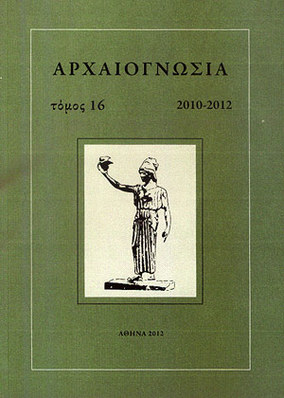Τα εργαστήρια του αργυρούχου μεταλλεύματος της Λαυρεωτικής
Part of : Αρχαιογνωσία ; Vol.11, No.1-2, 2001, pages 155-172
Issue:
Pages:
155-172
Parallel Title:
The silver-ore processing workshops of the Lavrion region
Section Title:
Μελέτες-Articles
Author:
Abstract:
he greatest achievement in the mining history of the Lavrion Region hasundoubtedly been the invention of the washery for the processing and cleaning of the ore of all the constituents that were not silver-bearing lead. Until the invention of the washery, only the rich in argentiferous lead deposits were utilizable, due to the lack of the technology needed. The ores, which were poor in argentiferous lead, were not exploitable. The washery made possible the exploitation of even the poor ores. Taking into consideration that the Lavrion substratum contained mainly poor lodes, it is obvious that this technological invention expanded automatically the mineral wealth of Athens. Due to its economic significance, this achievement helped substantially the evolution of the Athenian Democracy.The operation of the washery demanded the use of large amounts of water; therefore, the metallurgists originally had built their washeries in areas where there were natural water sources, e.g. alongside the stream banks. A similar installation of washeries has been recently excavated in the Bertseko Valley, south of Kamariza at Lavrion. In this valley lie the remains of numerous washeries, which were very near each other, thus giving evidence for the existence of an enormous metallurgical plant. The washeries in the Bertseko Valley are all cut into the rock. The earliest of them are dated to the end of the 6th or at the beginning of the 5th century BC, according to data provided by the pottery finds. Their form indicates clearly that these washeries were the predecessors of the rectangular washeries Type I of the classical period. Their shape also proves that the buildess of these washeries were still at a stage of exploration and experimentation as regards the improvement of the operation and morphological features of the structure.It seems that the exploitation of the area and the number of washeries were continually increasing, as was the need for water supply for the cleaning of the ore which could not be fully satisfied by the existing water sources. Therefore, the metallurgists disconnected the operation of the washeries from the natural water sources and started constructing large open-air cisterns for the collection and maintenance of rainwater, which would then be used for the operation of the washeries all year round. In this way, the miners were no longer obliged to transport the mined ore from the mine sites to areas where there was natural water flow. They could and did organise their ore-processing «ergasteria» (workshops) anywhere, in fact near their mines, in order to avoid the burden of transport both in terms of time lost and labour. The washeries and the open-air cisterns led steadily to the development of a specific type of metallurgical workshop which did not exist in the pre-classical period, but was from then on operating for the processing and cleaning of the ore. This type of workshop has served as the main means of silver production in the Lavrion region during the classical period.
Subject:
Subject (LC):
Keywords:
Αττική
Notes:
Ο Ευάγγελος Χ. Κακαβογιάννης είναι αρχαιολόγος, Περιέχει εικόνες και κατόψεις




